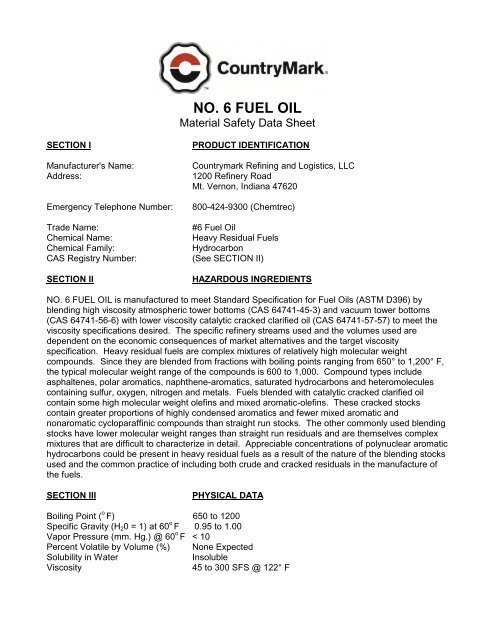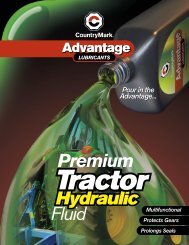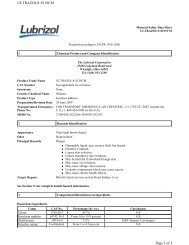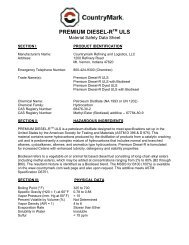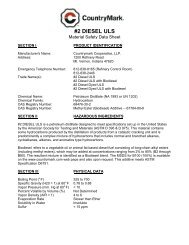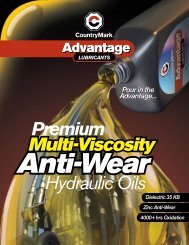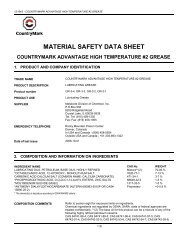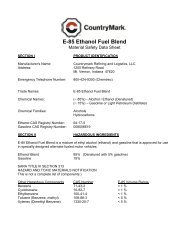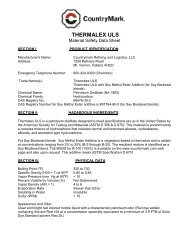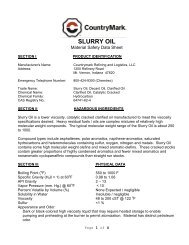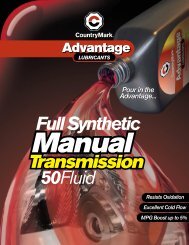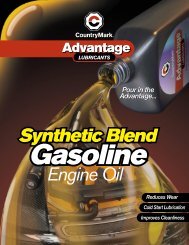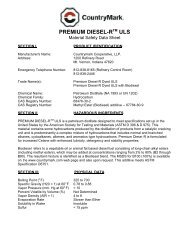NO. 6 FUEL OIL - CountryMark
NO. 6 FUEL OIL - CountryMark
NO. 6 FUEL OIL - CountryMark
Create successful ePaper yourself
Turn your PDF publications into a flip-book with our unique Google optimized e-Paper software.
<strong>NO</strong>. 6 <strong>FUEL</strong> <strong>OIL</strong><br />
Material Safety Data Sheet<br />
SECTION I<br />
Manufacturer's Name:<br />
Address:<br />
Emergency Telephone Number:<br />
Trade Name:<br />
Chemical Name:<br />
Chemical Family:<br />
CAS Registry Number:<br />
SECTION II<br />
PRODUCT IDENTIFICATION<br />
Countrymark Refining and Logistics, LLC<br />
1200 Refinery Road<br />
Mt. Vernon, Indiana 47620<br />
800-424-9300 (Chemtrec)<br />
#6 Fuel Oil<br />
Heavy Residual Fuels<br />
Hydrocarbon<br />
(See SECTION II)<br />
HAZARDOUS INGREDIENTS<br />
<strong>NO</strong>. 6 <strong>FUEL</strong> <strong>OIL</strong> is manufactured to meet Standard Specification for Fuel Oils (ASTM D396) by<br />
blending high viscosity atmospheric tower bottoms (CAS 64741-45-3) and vacuum tower bottoms<br />
(CAS 64741-56-6) with lower viscosity catalytic cracked clarified oil (CAS 64741-57-57) to meet the<br />
viscosity specifications desired. The specific refinery streams used and the volumes used are<br />
dependent on the economic consequences of market alternatives and the target viscosity<br />
specification. Heavy residual fuels are complex mixtures of relatively high molecular weight<br />
compounds. Since they are blended from fractions with boiling points ranging from 650° to 1,200° F,<br />
the typical molecular weight range of the compounds is 600 to 1,000. Compound types include<br />
asphaltenes, polar aromatics, naphthene-aromatics, saturated hydrocarbons and heteromolecules<br />
containing sulfur, oxygen, nitrogen and metals. Fuels blended with catalytic cracked clarified oil<br />
contain some high molecular weight olefins and mixed aromatic-olefins. These cracked stocks<br />
contain greater proportions of highly condensed aromatics and fewer mixed aromatic and<br />
nonaromatic cycloparaffinic compounds than straight run stocks. The other commonly used blending<br />
stocks have lower molecular weight ranges than straight run residuals and are themselves complex<br />
mixtures that are difficult to characterize in detail. Appreciable concentrations of polynuclear aromatic<br />
hydrocarbons could be present in heavy residual fuels as a result of the nature of the blending stocks<br />
used and the common practice of including both crude and cracked residuals in the manufacture of<br />
the fuels.<br />
SECTION III<br />
PHYSICAL DATA<br />
Boiling Point ( o F) 650 to 1200<br />
Specific Gravity (H 2 0 = 1) at 60 o F 0.95 to 1.00<br />
Vapor Pressure (mm. Hg.) @ 60 o F < 10<br />
Percent Volatile by Volume (%) None Expected<br />
Solubility in Water<br />
Insoluble<br />
Viscosity<br />
45 to 300 SFS @ 122° F
#6 Fuel Oil<br />
Material Safety Data Sheet<br />
Page 2 of 4<br />
Appearance and Odor:<br />
Dark or black-colored high viscosity liquid requiring heated storage to enable pumping and<br />
preheating at the burner to permit atomization. Material has distinct petroleum odor.<br />
SECTION IV<br />
FIRE AND EXPLOSION HAZARD DATA<br />
Flash Point (PM)<br />
> 150° F<br />
Classification: Flammable Liquid NA 1993<br />
Flammable Limits: LEL N/A UEL N/A__<br />
Extinguishing Media:<br />
Small Fires:<br />
Dry Chemical, Carbon Dioxide, water spray, or foam.<br />
Large Fires:<br />
Water spray, fog, or foam<br />
Hazardous Decomposition Products:<br />
WARNING: Hydrogen Sulfide (H 2 S) and other hazardous vapors may evolve and collect in<br />
the headspace of storage tanks or other enclosed vessels. Hydrogen sulfide is an extremely<br />
flammable and highly toxic gas. Incomplete combustion may form toxic materials: Carbon<br />
Dioxide and Carbon Monoxide, plus various unidentified organic hydrocarbons may be<br />
formed.<br />
Special Fire Fighting Procedures:<br />
Cool containers with water spray to prevent re-ignition.<br />
Unusual Fire and Explosion Hazards:<br />
Avoid heat, open flames, and oxidizing agents such as Chlorine, Permanganates, and<br />
Dichromates.<br />
SECTION V<br />
HEALTH HAZARD<br />
Threshold Limit Value:<br />
No applicable information was found.<br />
Effects of Overexposure:<br />
None expected under normal conditions of use.<br />
Emergency and First Aid Procedures:<br />
IF IN EYES - Flush with large amounts of water, lifting upper and lower lids occasionally. Get<br />
medical attention.<br />
IF ON SKIN - Thoroughly wash exposed area with soap and water. Remove contaminated<br />
clothing. Launder contaminated clothing before reusing.<br />
IF INHALED - If affected, remove individual to fresh air. If breathing is difficult, administer oxygen.<br />
If breathing has stopped, give artificial respiration. Keep person warm, quiet, and get medical<br />
attention.<br />
IF SWALLOWED - Do not induce vomiting. Keep person warm, quiet and get medical attention.<br />
SECTION VI<br />
REACTIVITY DATA<br />
Stable X Unstable _____<br />
Incompatability (Materials to avoid): Avoid contact with strong oxidizing agents like Chlorine,<br />
Permanganates, and Dichromates.<br />
Hazardous Decomposition Products:<br />
May form toxic materials of Carbon Dioxide, Carbon Monoxide, various hydrocarbons, etc. as<br />
combustion by-products.<br />
Hazardous Polymerization: May Occur Will Not Occur X__
#6 Fuel Oil<br />
Material Safety Data Sheet<br />
Page 3 of 4<br />
SECTION VII<br />
SPILL OR LEAK PROCEDURES<br />
Steps to be taken in case material is released:<br />
Small Spill: Eliminate all ignition sources (smoking, flares, flames, including pilot lights, electrical<br />
sparks, and etc.). Absorb liquid on paper, vermiculite, floor absorbent, or other absorbent<br />
material and place in non-leaking container for proper disposal.<br />
Large Spill: Eliminate all ignition sources (smoking, flares, flames, including pilot lights, electrical<br />
sparks, and etc.). Persons not wearing protective equipment should be excluded from area of<br />
spill until clean-up has been completed. Stop spill at source, dike area of spill to prevent<br />
spreading, pump liquid to salvage tank or truck. Remaining liquid may be taken up on sand,<br />
clay, earth, floor absorbent or other absorbent material and shoveled into non-leaking<br />
containers for proper disposal. Prevent run-off to sewers, streams or other bodies of water. If<br />
run-off occurs, notify proper authorities as required.<br />
Waste Disposal Method:<br />
Small Spill: Contaminated absorbent may be deposited in a landfill in accordance with local, state<br />
and federal regulations.<br />
Large Spill: Reclaim as much as possible for reprocessing or salvage. Destroy by liquid<br />
incineration. Contaminated absorbent may be deposited in a landfill in accordance with local,<br />
state and federal regulations.<br />
SECTION VIII<br />
SPECIAL PROTECTION INFORMATION<br />
Respiratory Protection:<br />
Normally not needed for normal exposure. A NIOSH/MSHA jointly approved air supplied respirator<br />
is advised in absence of proper environmental control. Firefighters require SCBA Positive<br />
Pressure Breathing Apparatus when involved in petroleum fires.<br />
Ventilation:<br />
Normally ventilation is not required for usual conditions of use. If ventilation is needed, explosion<br />
proof motors and fans are required to provide sufficient mechanical (general and/or local exhaust)<br />
ventilation to maintain exposure below TLV(S).<br />
Personal Protective Equipment and Apparel:<br />
Gloves: Wear petroleum resistant gloves such as: Neoprene, Nitrile, rubber gloves, etc.<br />
Eye Protection: Safety goggles or face shield for protection from splashing in eyes.<br />
Other Protective Equipment: Wear impervious protective clothing and boots appropriate for<br />
work situations to prevent repeated or prolonged skin contact. Launder contaminated clothing<br />
before wearing.<br />
SECTION IX<br />
SPECIAL PRECAUTIONS<br />
Precautions to be taken when handling and storing:<br />
Keep all containers in upright position. Store in a cool, dry, well ventilated area away from heat,<br />
ignition, and strong oxidizers. Do not allow smoking in areas of use or dispensing. Motors, fans,<br />
switches, and etc. in area of use or dispensing should be explosion proof. Ground containers<br />
when filling. Prevent all static and electric sparks.
#6 Fuel Oil<br />
Material Safety Data Sheet<br />
Page 4 of 4<br />
Other Precautions:<br />
Have written confined space and tank entry procedures. Never allow tank entry without checking<br />
OXYGEN AND VAPOR levels.<br />
WARNING: Hydrogen Sulfide (H 2 S) and other hazardous vapors may evolve and collect in the<br />
headspace of storage tanks or other enclosed vessels. Hydrogen sulfide is an extremely<br />
flammable and highly toxic gas. Use safety harness and safety line on person entering a tank.<br />
Stand-by person required with protective equipment available.<br />
SECTION X<br />
TOXICOLOGICAL INFORMATION<br />
No applicable information was found.<br />
SECTION XI<br />
DOT LABELING INFORMATION<br />
Proper Shipping Name:<br />
Hazardous Classification:<br />
Identification Number: NA 1993<br />
Label(s) Required:<br />
Flammable Liquid<br />
Heavy Residual Fuels<br />
Flammable Liquid, 3, NA 1993, PG III<br />
(DOT ERG No. 27)<br />
DISCLAIMER OF LIABILITY<br />
The information in this MSDS was obtained from sources which we believe are reliable; however, the<br />
information is provided without any warranty, expressed or implied, regarding its correctness.<br />
The conditions or methods of handling, storage, use and disposal of this product are beyond our<br />
control and may be beyond our knowledge. For this and other reasons, we do not assume<br />
responsibility and expressly disclaim liability for loss, damage or expense arising out of or in any way<br />
connected with the handling, storage, use or disposal of this product.<br />
This MSDS was prepared and is to be used only for this product. If this product is used as a<br />
component in another product or mixed with another product, this MSDS information may not be<br />
applicable.<br />
Date of Preparation or Last Change: December 2012


